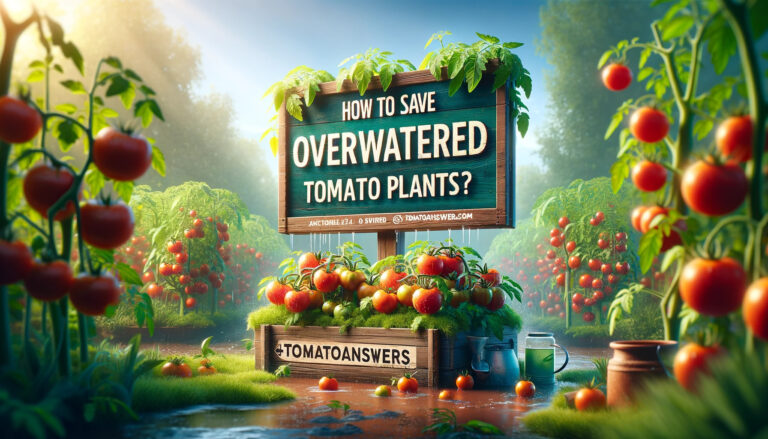In This Article
How to Save Overwatered Tomato Plants?
Saving an overwatered tomato plant can seem daunting, but it’s not that hard. With a few simple steps, you can bring your tomato plants back to life and get the delicious tomatoes you expected.
In this article, I’ll share my experience and explain the signs of overwatering, how to inspect tomato plant roots, and how to fix an overwatered tomato plant.
So, let’s get started and learn how to save your overwatered tomato plants!
Signs of Overwatered Tomato Plants
I’m noticing drooping stems and foliage, often the first signs that something is amiss with my tomato plants.
It’s common to make mistakes when watering tomato plants, so it’s important to understand how much water they need and how overwatering can impact their health.
To help diagnose the issue, I inspect the roots, looking for signs of root rot like brown, black, limp, or mushy roots instead of white and puffy.
If the overwatering is caught before the roots are damaged, I provide dry soil and withhold water until the soil dries out.
If the roots are damaged, I repot the plant with dry soil and add a support to keep it upright. I also fertilize the plant with a balanced NPK fertilizer to provide nutrients.
To prevent overwatering, I ensure sufficient drainage, maintain a regular watering schedule, watch the weather, and provide 1-2 inches of water per week for garden plants and 1 gallon per day for potted plants.
How to Inspect Tomato Plant Roots
I’m inspecting tomato plant roots to determine if they’re healthy. To do this, I’ll need to remove soil to uncover them, usually in the top 8-12 inches. When I uncover them, I look for healthy white and turgid roots instead of brown, black, limp, or mushy ones. This is the surest way to detect root rot, which can be caused by excessive soil moisture.
I must move the plant to a new, drier spot to revive damaged roots and report it with dry soil. I can use a shovel in the garden to dig up the plants and remove as much soil as possible. Then, I’ll rinse the root ball, cut out any mushy or discolored roots, and replant in a dry spot. Reviving the plant involves providing nutrients and withholding water until the soil dries.
If I can catch the signs of overwatering early, I can prevent root rot and help the plant recover.
How to Fix an Overwatered Tomato Plant
I’ve identified the overwatering problem, so I need to fix it. To restore good health and revive wilted plants, I must provide dry soil, inspect the roots, and provide nutrients.
For tomato plants in pots, I’ll need to remove the plant, shake or rinse off soggy soil, and cut off mushy and discolored roots. Then, I’ll refill the pot with a new dry mix and repot the plant.
Garden-grown plants require a bit more work. Using a shovel, I’ll dig up the plant, rinse the root ball, and cut off dark, waterlogged roots before replanting in a dry location.
| Watering Techniques | Proper Drainage |
|---|---|
| Soil Moisture Levels | Root Health |
| Reviving Wilted Plants |
Ways to Prevent Overwatering
I can prevent overwatering by following a few simple steps. Proper drainage is key—avoid planting tomatoes in low areas, use pots with plenty of drainage holes, and check the soil for standing water. A regular watering schedule is important as it allows the soil surface to dry slightly between irrigations. I should also monitor rainfall and adjust the amount of water accordingly.
I should provide 1 gallon of water daily for potted plants and 1 to 2 inches per week for garden plants. Hose timers are convenient, but remember to always account for rainfall. I shouldn’t try to compensate for missed watering with additional irrigation, as this can saturate roots.
To avoid mistakes, I should also consider using soil moisture sensors and different watering techniques for potted plants versus garden plants. Overwatering can reduce yield and damage roots, so I should be aware of the impact it can have.
Hydrating a Tomato Plant
By hydrating a tomato plant correctly, I can help ensure its recovery. Rehydrating techniques should consider the plant’s watering frequency and soil moisture levels. Proper drainage systems are also important in helping to prevent overwatering.
When rehydrating a tomato plant, I must assess the root health and ensure that the roots are still white and puffy. If the roots are brown or black and limp or mushy, I must repot the plant with dry soil. I should also provide the plant with a balanced NPK fertilizer, such as 10-10-10, to help restore its health.
Frequently Asked Questions
How Can I Tell if I Have Given My Tomato Plant Too Much Water?
I can tell if I’ve given my tomato plant too much water by inspecting the soil types, checking the water frequency, and applying the correct fertilizing and disease prevention methods. Following the right watering guidelines can help me avoid overwatering.
What Are the Best Techniques for Inspecting Tomato Plant Roots?
Inspecting tomato plant roots requires soil aeration, proper drainage, and monitoring watering cycles to avoid root rot. Feel the soil moisture to determine if roots are healthy – use a trowel to examine further.
How Long Will It Take for My Overwatered Tomato Plant to Recover?
It depends on the severity of the damage to the roots and soil. If using proper watering techniques and soil quality, with adequate drainage solutions and fertilizers, recovery should occur in one to two weeks with a regular watering schedule.
What Is the Difference Between Overwatering and Underwatering a Tomato Plant?
Overwatering a tomato plant can cause water-logging, while underwatering can lead to drought stress. Soil type, watering frequency, and fertilizer needs affect the plant’s drought tolerance. Careful attention to these factors can help ensure your tomato plants get the right water.
Is It Possible to Save a Tomato Plant With Extensive Root Damage?
Yes! With root protection, proper soil moisture, and a mindful watering frequency, tomato plants with extensive root damage can be saved. Drainage solutions, like repotting with dry soil and monitoring root health, are key to reviving your beloved plants.
Conclusion
Overwatering your tomato plants can be a stressful experience, but with the right knowledge and steps, you can bring your tomato plants back from the brink.
I learned that “prevention is better than cure,” so it’s important to be vigilant and monitor your plants regularly to ensure you don’t overwater them.
Following my steps, you can have a thriving tomato patch with healthy and delicious tomatoes!

